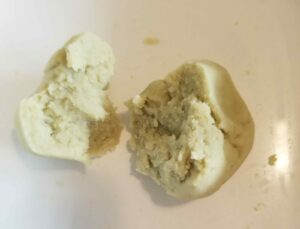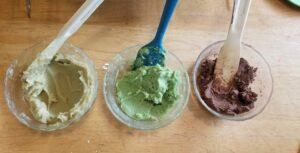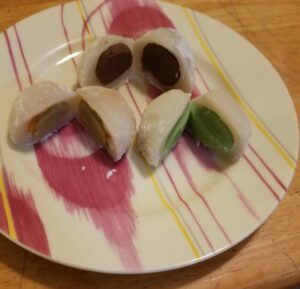Allergic to anko? Tired of looking through the shelves at your local Asian market for premade daifuku mochi you can eat? Tired enough to make your own? Then grab some mochiko and head to the produce aisle to pick up a Japanese sweet potato. Steamed and mashed, this variety (NOT orange American ones, though purple miiiiight do okay) makes a filling that’s texturally similar to smooth red bean paste (koshi-an), and takes flavoring very nicely.
And because you’re not here for a cultural history of mochi or a linguistic analysis of “adzuki,” here’s the recipe.
——————
Sweet Potato Daifuku Filling
Peel a Japanese sweet potato (satsumaimo, with purple-red skin and cream-colored flesh) and slice thinly. Place slices in a microwave-safe dish, add a couple of tablespoons of water, cover and cook on high for a minute or two at a time, rearranging pieces every once in a while, until the slices break easily when pressed. Remove sweet potato to another dish and drain the water. Mash sweet potato as thoroughly as you can, then push it through a sieve to remove any fibers or discolored bits. (A food processor won’t do very well with this as the sweet potato needs to be dry and doughy, a texture food processors and blenders don’t like.) You can skip the sieving if you like, but I highly recommend it.

Weigh out 100 grams of sieved sweet potato into a bowl and add up to 1 Tbsp (about 15g) of flavoring powder. The variations I tried:
1 Tbsp (15g) mango juice powder (this turns out rather sticky, so wet your hands when rolling)
1 Tbsp (15g) honeydew milk tea powder (we also have taro, but our allergic person prefers honeydew)
5g cocoa powder and 10g powdered sugar (sorry, I just straight weighed these)

Mix with a spoon or spatula until uniform. Divide each flavor into 8 portions and roll into balls. If you like, roll the balls in chocolate shavings, diced dried fruit, coconut, or chopped nuts/seeds (if that’s cool with your immune system). Substitute for the balls of anko (red bean paste) in just about any daifuku mochi recipe out there. Store in the fridge, because this recipe is about safety and I don’t know how it’ll hold up at room temp.

Itadakimasu!